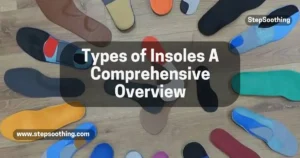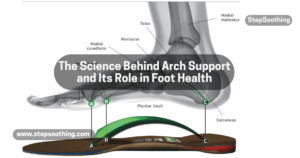If you’ve experienced foot pain, you’ve likely come across the terms “Orthotics vs Insoles.” Though used interchangeably, they differ significantly. Understanding their distinction is crucial for addressing your foot concerns effectively.
In this article, we’ll delve into the disparities between Orthotics and Insoles, examining their benefits and uses to assist you in making an informed choice. Whether you’re dealing with plantar fasciitis or looking for extra support, explore this comprehensive guide to Orthotics vs Insoles.
Orthotics vs Insoles:
A Guide to Tailored Orthotic Solutions

What are Orthotics?
Orthotics are custom-made medical devices crafted to fit inside your shoe. They offer support for your feet, alleviating pain and discomfort caused by various foot and ankle conditions.
Tailors can customize orthotics to address specific foot problems like flat feet, high arches, or plantar fasciitis. They also use them to enhance gait and distribute weight evenly across the foot.
What are Insoles?
Insoles refer to sandal or shoe inserts that lie under the sole of your foot, providing extra cushioning and support. They are removable and can be mass-produced to fit different shoe sizes.
Insoles enhance the comfort of your shoes and can address common foot conditions. They come in various materials and designs, including memory foam, gel, and arch support insoles.
The Difference Between Orthotics and Insoles
While “orthotics” and “insoles” are sometimes used interchangeably, they differ significantly. Orthotics are custom-made to fit your unique foot shape and cater to individual foot conditions. Podiatrists or foot specialists often prescribe them, providing a higher level of personalization and targeted support.
In contrast, manufacturers typically offer insoles over-the-counter, designing them to provide generalized cushioning and support. They do not specifically craft them for individual foot concerns but can offer relief for common issues. Insoles are more readily available and suitable for individuals who don’t need highly customized support.

Common Foot Conditions and Treatment Options
Foot pain can arise from various foot and ankle conditions. Understanding these conditions and their treatment options can help you determine whether orthotics or insoles are more appropriate for your needs. Here are a few common foot conditions:
- Plantar Fasciitis: Involves inflammation of the plantar fascia, a ligament along the bottom of the foot. Orthotics designed for plantar fasciitis can provide support and relieve pressure.
- Flat Feet: Occur when the arch of the foot collapses, causing the entire sole to touch the ground. Orthotics for flat feet can offer arch support and even weight distribution.
- High Arches: Involve an excessive upward curve in the midsection of the foot. Orthotics with extra cushioning and support can alleviate pressure and provide stability.
- Heel Pain: Conditions like Achilles tendonitis or heel spurs can lead to severe heel pain. Custom-made insoles designed for pain relief can cushion and support the heel.
- Ball of the Foot Pain: Metatarsalgia, inflammation of the ball of the foot, can cause discomfort. Custom orthotics with extra cushioning in the metatarsal area can relieve pressure.
Are Superfeet Insoles Worth It?
Types of Orthotics and Their Applications
Orthotics can be crafted from a range of materials, such as soft foam, rigid plastic, or a blend of both. The suitable type hinges on your distinct foot condition and requirements. Transitioning to specific examples, common types of orthotics encompass:
- Custom-made Orthotics: Designed based on a 3D scan or mold of your feet, providing a highly personalized fit and targeted support.
- Prefabricated Orthotics: Pre-made, non-customized devices available for general foot support and cushioning. They can be a more affordable option for those without specific foot concerns.
- Heel Cups and Inserts: Focus on providing support and cushioning for the heel, helpful for conditions like heel spurs or plantar fasciitis.
Choosing Between Orthotics and Insoles: Which is Right for You?
When deciding between orthotics and insoles, consider your specific foot condition, the level of support you need, and your budget. Custom orthotics, with their custom-fit and personalized support, offer targeted relief for individuals with specific foot concerns.
Insoles, on the other hand, can provide general cushioning and support at a more affordable price point. If diagnosed with a foot condition by a podiatrist or foot specialist, custom orthotics may be the most suitable option. They are designed to address your specific needs, target your pain points, and provide long-term relief.
However, for general comfort and support without a specific foot condition, over-the-counter insoles can be a practical and cost-effective choice.
The Benefits of Custom Orthotics:
Custom orthotics offer several advantages compared to over-the-counter insoles.
- Personalization: Designed to fit your unique foot shape, providing personalized support and comfort.
- Targeted Support: Specifically targets and alleviates pain and discomfort associated with your specific foot condition, improving overall foot function and alignment.
- Durability: Typically made from high-quality materials, ensuring durability and longevity.
- Proper Fit: Designed to fit snugly inside your shoes, minimizing slippage and providing consistent support throughout the day.
- Long-Term Relief: Addresses the root cause of your foot condition, aiming to provide lasting relief by correcting biomechanical issues and improving foot function.
- Versatility: Can be designed to fit various types of shoes, from athletic footwear to dress shoes, allowing you to experience the benefits of targeted support in any situation.
While custom orthotics may require a higher upfront investment compared to over-the-counter insoles, their long-lasting benefits and ability to address your specific foot concerns make them a worthwhile investment.

Over-the-Counter Insoles vs Custom Orthotics: Making the Right Choice:
Choosing between over-the-counter insoles and custom orthotics depends on your individual needs and preferences. Consider the following points when making your decision:
- Level of Support: If you have a specific foot condition or require targeted support, custom orthotics are the better option. Insoles provide more generalized cushioning and may not adequately address specific pain points.
- Budget: Custom orthotics are generally more expensive than over-the-counter insoles. However, their personalized fit and long-term benefits may outweigh the upfront cost.
- Foot Structure: Considering your foot structure and any specific biomechanical issues, it’s important to note that custom orthotics can address these concerns with tailored support. In contrast, insoles may provide more of a one-size-fits-all solution.
- Activity Level: If you engage in high-impact activities or have a physically demanding lifestyle, custom orthotics can provide the necessary support and shock absorption. However, insoles may not offer the same level of durability and performance for intense activities.
Ultimately, the decision should be grounded in your unique circumstances and the guidance of a healthcare professional. By consulting with a podiatrist or foot specialist, you can effectively determine the most suitable choice for your specific foot needs.
Tips for Shopping for Insoles
If you decide to go with over-the-counter insoles, here are some tips to keep in mind.
- Know your foot type: Understand your foot arch type (e.g., high arches, flat feet) to choose insoles or orthotics that provide the appropriate level of support.
- Consider your activity: Different activities have different support needs. Look for insoles designed specifically for running, walking, or sports activities, depending on your lifestyle.
- Try before you buy: If possible, try on the insoles in-store to ensure they fit comfortably inside your shoes and provide the desired level of cushioning and support.
- Read reviews: Look for customer reviews online to get an idea of the effectiveness and durability of the insoles you are considering.
- Replace regularly: Over-the-counter insoles and orthotics may wear out over time. Replace them when they show signs of wear or every six months to maintain optimal support.
Remember, while over-the-counter insoles can provide temporary relief and added comfort, they may not address underlying foot conditions as effectively as custom orthotics.
Frequently Asked Questions
Custom orthotics can last for several years with proper care. However, the lifespan may vary depending on factors like usage, foot condition severity, and the materials used. It is recommended to have them evaluated by a podiatrist annually to ensure they are still providing optimal support.
Indeed, custom orthotics can usually be transferred between different pairs of shoes. Designed to fit various footwear types, they enable you to experience personalized support throughout your shoe collection.
In some cases, health insurance plans may cover custom orthotics if they are deemed medically necessary. Check with your insurance provider to determine coverage and any requirements, such as a physician’s prescription or documentation.
Yes, some over-the-counter insoles come with guidelines for trimming to ensure a proper fit. However, exercise caution when trimming to avoid compromising the structure and effectiveness of the insole.
Insoles designed specifically for high heels can provide additional cushioning and support, helping to alleviate foot pain associated with wearing these types of shoes. Look for insoles with features tailored for high heels, such as metatarsal pads or arch support.
How to Clean Your Smelly Insoles
Closing Thoughts on Orthotics vs Insoles
In conclusion, understanding the difference between orthotics and insoles is crucial in finding the right solution for your foot health needs. Recognize the disparity between insoles and orthotics, Orthotics offer personalized support for specific foot conditions, while insoles provide general cushioning and comfort.
Consult with a healthcare professional to determine the most suitable option for you. Whether you choose custom insoles or over-the-counter insoles, both can contribute to improved foot comfort and overall well-being.
Remember to prioritize foot health and invest in the support you need to keep your feet happy and pain-free.



